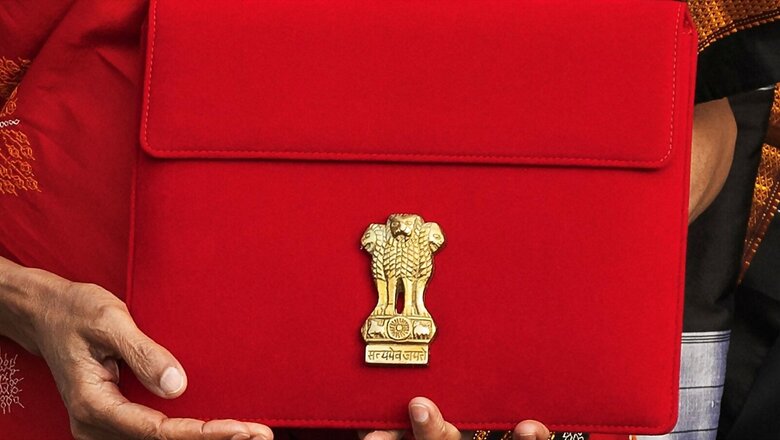
views
The Union Budget 2023-24 was presented against the backdrop of geopolitical volatility and global economic slowdown. The Budget was able to balance the fiscal consolidation agenda with the broad themes laid out in the previous budget to a great extent, according to a report by India Ratings and Research (Ind-Ra).
Deficit Ratios Trending Downwards
The fiscal marksmanship witnessed a major setback in FY21 due to COVID-19, but since then there has been some improvement. In FY22, the actual fiscal deficit stood at 6.7 per cent of GDP against the budgeted 6.8 per cent. Even for FY23, the revised estimate (RE) for the fiscal deficit is pegged at 6.4 per cent same as the budget estimate (BE). While the revenue deficit is budgeted to drop to 2.9 per cent of GDP in FY24 (FY23RE: 4.1 per cent), the fiscal deficit is budgeted to fall to 5.9 per cent.
Besides the fiscal marksmanship, the quality of deficit has improved, which is measured as the revenue deficit to fiscal deficit ratio (the lower the better). Between FY09-FY23RE, the revenue deficit to fiscal deficit ratio averaged 71 per cent. However, in FY24BE, this ratio works out to be 48.7 per cent. Encouragingly, over half of the fiscal deficit is budgeted to be deployed for capital expenditure (comparable to the period of FY08).
Debt Sustainability to Remain an Issue
The leverage (debt/GDP) of the general government (states and the union government) has been rising since FY16, after remaining range bound during FY11-FY15. The debt/GDP spiked to 91.7 per cent in the COVID-19 impacted FY21 due to the deterioration in economic activity, higher expenditure and lower revenue receipt. Debt sustainability rests on two key indicators, namely the rate spread (difference between the nominal GDP growth and the rate of interest on accumulated debt) and the primary balance (fiscal balance net of interest payments).
Since deficits in the primary accounts of governments are common, the rate spread mainly determines the trajectory of debt sustainability. “In FY23, the debt/GDP of the general government declined to 83.4% from 85.7% in FY22 due to a higher rate spread. However, with the receding inflation and moderation in economic growth in FY24, the debt/GDP of the general government is expected to remain sticky at the current levels,” said Analyst Paras Jasrai. The debt-GDP of the Union government is pegged at 56.2 per cent as per FY24BE, higher than 55.9 per cent in FY23RE as the rate spread is expected to drop to 3.4 percentage points (pp) in FY24BE from 8.5pp in FY23RE.
Reduction in Size of Revenue Expenditure
Although the revenue expenditure is budgeted to increase by 1.2 per cent to Rs 35.02 lakh crore in FY24 over FY23RE, the revenue expenditure-GDP ratio is budgeted to fall to 11.6 per cent in FY24BE from 12.7 per cent in FY23RE. This reduction has been largely due to a compression in the committed part of the revenue expenditure. The committed revenue expenditure, which includes interest payments, subsidies, salaries and pensions, is pegged to decline by 76 bps to 6.7 per cent of GDP in FY24BE from FY23RE.
The other (non-committed) revenue expenditure-GDP has witnessed a smaller decline of 30 bps in the same period. This has been due to a decline (or a modest increase relative to the growth in nominal GDP) in the allocations towards various key schemes such as Mahatma Gandhi National Rural Employment Guarantee Program, Crop Insurance Scheme (Pradhan Mantri Fasal Bima Yojana), Pradhan Mantri Awas Yojna, Pradhan Mantri Poshan Shakti Nirman (PM POSHAN), Saksham Anganwadi and POSHAN 2.0 in FY24BE compared to FY23RE.
Capex the Way Forward
Part of the reduction in the size of the revenue expenditure (106 bps) has been directed towards ramping-up the capital expenditure (capex) in FY24BE. The capex has been budgeted at a 19-year high of 3.3 per cent of GDP in FY24 (FY23RE: 2.7 per cent). The 65 bps increase in capex-GDP is the biggest quantum of increase since FY08 (77bp). This included an enhanced transfer to the tune of INR1.3 trillion to states in the form of interest free loans in FY24BE.
“Apart from this, there has been an increased outlay to sectors such as roads, railways, defence, petroleum & natural gas, and telecom. Overall, the total capex by the union government and public enterprises is budgeted to rise to a six-year high of 4.9% of GDP in FY24, after a downswing of three years. Ind-Ra expects this to support and reinvigorate the investment demand in the economy which hopefully will crowd in the much-awaited private investment,” the report said.
Ind-Ra said the employment generation and push to consumption demand would be limited due to the long gestation period of infrastructure capex. it also said the boost to employment and thereby demand would have been more, had the proportion of capex spent on projects having a short gestation period and high employment intensiveness been more.
Higher Tax Buoyancy Indicates Collection Efficiency
The net-tax/GDP ratio had been stagnant at an average 7.1 per cent during FY10-FY21, despite the changes in tax rates and reforms. However, lately due to the higher formalisation of the economy and better compliance, the ratio has improved. It is budgeted to rise to a 15-year high of 7.7 per cent in FY24. Notwithstanding the moderation in net-tax revenue growth, the net-tax buoyancy (ratio of net-tax revenue growth and nominal GDP growth) is budgeted to improve to 1.11x in FY24 from 1.01x in FY23RE, indicating an improvement in the collection efficiency by the tax administration.
On the non-debt capital receipts front, disinvestment targets set by the union government have been a hard nut to crack. Despite setting a six-year low target of Rs 65,000 crore in FY23BE, the union government expects to garner Rs 60,000 crore from disinvestment receipts in FY23RE. For FY24BE, the target has been set at Rs 61,000 crore.
Lower Transfers to States: A Concern
While states undertake proportionately higher expenditure compared to the union government, they depend on the latter for resources. Tax devolution to states has been budgeted to grow 11.5 per cent in FY24 from FY23RE. However, the size of the total transfers to states (tax devolutions and grants) from the overall pool of tax resources collected by the union government has been decelerating over the past of couple of years.
In FY24BE, out of every Rs 100 collected by the Union government in the form of gross tax revenues, only Rs 53.5 will be transferred to the states (FY22: Rs 61.1). This is at a multi-decade low and could put pressure on the fiscal position of states as transfers from the union government remain a sizeable portion for states’ revenue. Besides, capping the fiscal deficit at 3.5 per cent of GSDP could mean lower capex by states in FY24.
Read all the Latest Business News here














Comments
0 comment